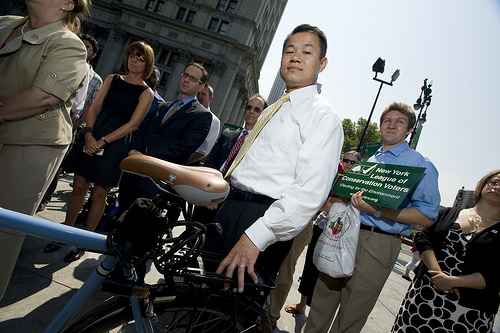When bike-share launches next month, eventually adding 10,000 public bicycles to the streets of New York City, it won’t bring new chaos and peril to city streets, contrary to recent statements from Comptroller John Liu. Even so, with the number of cyclists set to increase dramatically, the launch of bike-share is a good opportunity for the city to go even further in its successful efforts to improve street safety.

In a report that is much more positive about bike-share than its author's press statements would indicate [PDF], Liu endorses a slew of important safety-enhancing reforms that the city would do well to take note of -- as well as one to steer clear of.
In a press release this morning, Liu took an antagonistic tone toward the city’s bike-share program, and presented a pessimistic view of cycling in general. “In the rush to place ten thousand bicycles on our streets, City Hall may have pedaled past safety measures, a move that risks significantly exacerbating the number of injuries and fatalities of both bikers and pedestrians, especially those most vulnerable like young children and seniors,” Liu said. “Aside from the human toll, there is a real possibility that the Bike Share program will increase the number of legal claims against the City.”
Liu also aligned himself with still more extreme positions. “New York City is probably the most dangerous place in the world to ride a bicycle,” said AAA New York’s Robert Sinclair, Jr. in Liu’s release.
Those fears are misplaced, a fact that Liu’s own report makes clear. There, the comptroller’s office writes that “bicycling is becoming relatively safer” and argues that, thanks to the safety in numbers effect, more cyclists on the road will mean better bike safety after the launch of bike-share.
Moreover, bike-share riders actually have significantly better safety records than cyclists using their own two wheels. As Streetsblog previously reported, no one was seriously injured or killed on a London Barclays Cycle Hire bike in the first 4.5 million trips. In D.C., Capital Bikeshare users crashed only seven times in the first seven months of operation, with no serious injuries reported. More recently, the Boston Globe reported that city’s Hubway system had put up similarly laudable safety stats: no serious injuries in its first six months of operation. All of these cities use the same bikes as New York’s Citi Bike program.
Operating company Alta Bicycle Share has not been held liable for crashes in either Boston or D.C., where it also runs popular bike-share systems, according to the Times.
Still, it’s clear that more can and must be done to improve safety on New York City streets, and Liu has good ideas for each of the “three Es” of safety: engineering, enforcement and education.
To improve road design, Liu urges additional focus on the most dangerous intersections in the city. Nine of the 10 corners with the most bicycle crashes, he notes, are within the bike-share service area, including places like Bowery at Houston and Tillary at Adams. He also endorses an expansion of the Safe Streets for Seniors campaign, noting that seniors are both disproportionately vulnerable in traffic crashes and disproportionately concerned by the increased numbers of cyclists on the road.
On enforcement, Liu took his cues from a February City Council hearing that drew attention to the utter inadequacy of NYPD traffic enforcement resources. Liu calls for the police Accident Investigation Squad to respond to crashes that result in serious injury, not just those in which someone is killed, and for local precinct police to be fully trained in crash response protocols. He wants to see more cops on bikes, more cops clearing bike lanes of motor vehicles, and targeted enforcement focused on the most dangerous traffic violations.
And Liu wants to see bike safety education expanded everywhere: offered to more cyclists, included as part of drivers’ ed, and even worked into the public school curriculum. “There is ample precedent for this,” the report notes. “Almost all German, Dutch, and Danish schoolchildren receive comprehensive bicycle education and training in their schools by the 3rd or 4th grades.” (Last week, the city's premier provider of cyclist education, Bike New York, said its program was in danger due to a proposed NYPD policy change that would gut the group's budget.)
There’s really only one major false note within Liu’s report, and it’s the one he drew attention to today: a call for a mandatory helmet law in New York City. Streetsblog recently reported on the ill effects of helmet mandates, but it’s worth reiterating that whatever one thinks of helmet use, helmet laws are particularly incompatible with bike-share systems. The grab-and-go convenience of bike-share simply doesn’t work very well if users are required to plan ahead by bringing a helmet.
There is international consensus on this point. The world’s least-successful bike-share system, in Melbourne, Australia, is widely considered to have been kneecapped by that city’s helmet mandate. Cities like Mexico City and Tel Aviv have scrapped their helmet laws in preparation for the launch of bike-share. The sustainability advocates at the Pacific Northwest’s Sightline Institute have written that “our helmet fiats are the greatest legal obstacle to a bike share roll out” and are pushing to exempt bike-share riders from helmet laws in Washington and British Columbia.
Overall, it’s encouraging to see Liu, a citywide elected official and mayoral candidate, lend his support to a wide range of important safety efforts, and to bike-share itself. As he writes in his report, “Bike shares increase the capacity of existing transportation networks, provide users more mobility options, generate clear health benefits, and are environmentally-friendly.”





